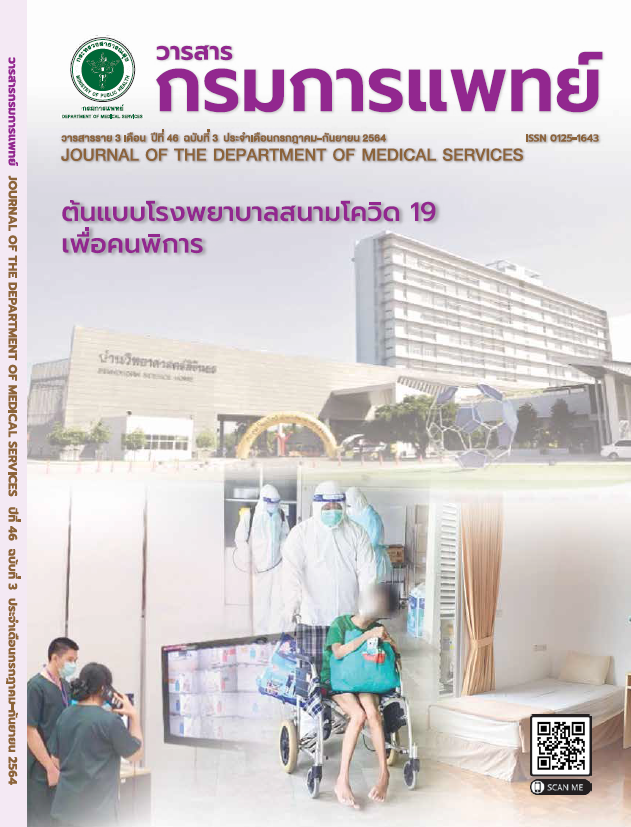ผลของการใช้แนวทางการปฏิบัติเพื่อป้องกันการติดเชื้อในกระแสเลือดจากการใส่สายสวนหลอดเลือดดำส่วนกลางในหอผู้ป่วยหนักศัลยกรรมทารกแรกเกิด สถาบันสุขภาพเด็กแห่งชาติมหาราชินี
คำสำคัญ:
การติดเชื้อในกระแสเลือด, การป้องกัน, สายสวนหลอดเลือดดำส่วนกลาง, PICC, ทารกแรกเกิด, NSICUบทคัดย่อ
ภูมิหลัง: การดูแลรักษาผู้ป่วยทารกแรกเกิดที่ต้องใส่สาย สวนหลอดเลือดดำส่วนกลาง สามารถทำให้เกิดภาวะแทรกซ้อนโดย เฉพาะอย่างยิ่งการติดเชื้อในกระแสเลือดจากสายสวนหลอดเลือดดำ ส่วนกลาง (central line associated bloodstream infection; CLABSI)วัตถุประสงค์: เพื่อศึกษาผลของอัตราการติดเชื้อใน กระแสเลือดจากการใส่สายสวนหลอดเลือดดำส่วนกลาง ภายหลัง การใช้แนวทางปฏิบัติที่ทบทวนปรับปรุงแล้วและประเมินผลการ ปฏิบัติตามแนวทางใหม่ของพยาบาลที่ปฏิบัติงานในหอผู้ป่วยหนัก ศัลยกรรมทารกแรกเกิด (Neonatal Surgical Intensive Care Unit; NSICU)วิธีการ: ขั้นตอนที่หนึ่งคือการปรับปรุงแนวทาง การปฏิบัติการป้องกัน CLABSI เดิม และประกาศใช้งานตั้งแต่ 1 เมษายน 2562 รวมทั้งมีการให้ความรู้และทบทวนแนวทาง ปฏิบัติแก่พยาบาลวิชาชีพ การประสานขอความร่วมมือกับกุมาร ศัลยแพทย์ วิสัญญีแพทย์ และเจ้าหน้าที่ห้องผ่าตัด ขั้นตอนที่สอง ของการศึกษาคือการเก็บข้อมูลของอาสาสมัคร 2 กลุ่ม กลุ่มที่หนึ่ง คือผู้ป่วยทารกแรกเกิด อายุตั้งแต่ 1-90 วันที่รักษาใน NSICU และ รับการใส่สายสวนหลอดเลือดดำส่วนกลาง ผู้ป่วยได้ถูกแบ่งเป็น 2 กลุ่มย่อย : 50 ราย ได้รับการรักษาในช่วงเวลาตั้งแต่ 1 เมษายน 2561 ถึง 31 มีนาคม 2562 และใช้แนวทางการป้องกันเดิม (กลุ่ม ย่อยที่ 1 หรือกลุ่มควบคุม) ผู้ป่วยอีก 50 รายได้รับการรักษาตั้งแต่ 1 เมษายน 2562 ถึง 31 มีนาคม 2563 และใช้แนวทางการป้องกัน ที่ปรับปรุงใหม่ (กลุ่มย่อยที่ 2 หรือกลุ่มทดลอง) อาสาสมัครกลุ่ม ที่ 2 คือพยาบาลวิชาชีพที่ปฏิบัติงานใน NSICU 20 ราย และ ปฏิบัติงานตามแนวทางการป้องกัน CLABSI ที่ปรับปรุงใหม่ประเมิน การดูแลผู้ป่วยทารกแรกเกิด 50 คน ตามข้อกำหนดของแนวทาง ปฏิบัติใหม่ผล: ข้อมูลทั่วไปผู้ป่วยทั้งสองกลุ่มส่วนใหญ่จะคล้ายกัน ยกเว้นเรื่องเพศ และน้ำหนักตัวแรกเกิด อัตราส่วนของเพศชายต่อ เพศหญิงเท่ากับ 23: 27 รายในกลุ่มควบคุมและ 35: 15 รายในกลุ่ม ทดลอง อัตราส่วนของน้ำหนักตัวแรกเกดิ น้อยกว่าปกติตอ่ น้ำหนักตัว แรกเกิดปกติเท่ากับร้อยละ 60 : ร้อยละ 40 ในกลุ่มควบคุม และ ร้อยละ 32 : ร้อยละ 68 ในกลุ่มทดลอง (p = .034) อัตราของการ เกิด CLABSI ในกลุ่มควบคุมสูงกว่าในกลุ่มทดลองอย่างมีนัยสำคัญ ทางสถิติ (6.81 : 1.69 ครั้งต่อ 1,000 วันใส่สายสวน; p = .025) กลุ่มควบคุมมีค่าเฉลี่ยจำนวนวันที่ใส่สายสวนหลอดเลือดดำส่วน กลางนานกว่ากลุ่มทดลอง (26.42 ± 2.79 vs 23.68 ± 2.79; p = .000) การใส่ PICC line ไม่มีการเกิด CLABSI เหมือนกันทั้งสองกลุ่ม โรคที่มีการเกิด CLABSI มักจะเกี่ยวข้องกับการผ่าตัดในช่องท้อง โดยเฉพาะอย่างยิ่งลำไส้อักเสบรุนแรงจนลำไส้เน่าและกระเพาะ อาหารและลำไส้อุดตัน ปัจจัยเสี่ยงจะทำให้เกิด CLABSI ได้มากคือ การใส่สายสวนโดยตรงตำแหน่งใกล้หลอดเลือดดำส่วนกลาง การใส่ สายสวนคาไว้เป็นเวลานานและโรคของผู้ป่วยที่เกี่ยวกับการผ่าตัด กระเพาะอาหารและลำไส้ ประเมินผลการปฏิบัติงานของพยาบาล วิชาชีพตามข้อกำหนดของแนวทางปฏิบัติถูกต้องมากกว่าร้อยละ 90 ในทุกด้าน (พิสัยร้อยละ 92-100)สรุป: ผลของการใช้แนวทาง การปฏิบัติเพื่อป้องกันการติดเชื้อในกระแสเลือดจากการใส่สายสวน หลอดเลือดดำส่วนกลางที่ทบทวนและปรับปรุงใหม่ สามารถช่วยลด อัตราการติดเชื้อจากสายสวนหลอดเลือดดำส่วนกลางลงได้ประมาณ 4 เท่าเปรียบเทียบกับการใช้แนวทางปฏิบัติเดิม รวมทั้งผลการ ปฏิบัติงานของพยาบาลวิชาชีพในหอผู้ป่วยหนักศัลยกรรมทารกแรก เกิดมีความถูกต้องมากกว่าร้อยละ 90 ในทุกกิจกรรมตามข้อกำหนด ของแนวทางปฏิบัติใหม่
เอกสารอ้างอิง
National Nosocomial Infections Surveillance System. National Nosocomial Infections Surveillance (NNIS) System Report, data summary from January 1992 through June 2004, issued October 2004. Am J Infect Control 2004; 32:470-85.
Rosenthal VD, Maki DG, Rodrigues C, Alvarez-Moreno C,Leblebicioglu H, Sobreyra-Oropeza M, et al.International Nosocomial Infection Control Consortium Investigators. Impact of International Nosocomial Infection Control Consortium (INICC) strategy on central line-associated bloodstream infection rates in the intensive care units of 15 developing countries. Infect Control Hosp Epidemiol 2010;31:1264-72.
Infection control and prevention Queen Sirikit National Institute of Child Health. Infection report of the Queen Sirikit National Institute of Child Health for the year 2016-2018.
Thamwiriyakul N, The effect of the development of guidelines for prevention of bloodstream infections from central venous catheter insertion in pediatric wards. [Thesis in Curriculum Studies and Training for a certificate showing knowledge and expertise in the medical profession Pediatrics branch of the Medical Council of Thailand]. Chonburi Hospital; 2014.
Duangsoi N, Effects of coaching on knowledge and practice of nurses in preventing infection from central venous catheterization. Master of Nursing Thesis Infectious Disease Nursing and Infection Prevention. Chiang Mai University; 2007.
Sudprasert C, Promchot P, Porntheerapat N, Pisittakarn N.The effect of Knowledge Management Program of nurses for practice on Pediatric Patient with Central Venous Catheters Care guidelines at Pediatric’s surgical Ward. Journal of the Department of Medical Services 2019; 44: 47-51.
Buetti N, Timsit JF. Management and prevention of central venous catheter-related infections in the ICU. Semin Respir Crit Care Med 2019; 40: 508-23.
Bierlaire S, Danhaive O, Carkeek K, Piersigilli F. How to minimize central line-associated bloodstream infections in a neonatal intensive care unit: a quality improvement intervention based on a retrospective analysis and the adoption of an evidence-based bundle. Eur J Pediatr2021; 180:449-60.
Chuengchitraks S, Sirithangkul S, Staworn D, Laohapand C.Impact of new practice guideline to prevent catheter-related blood stream infection (CRBSI): experience at the Pediatric Intensive Care Unit of Phramongkutklao Hospital. J Med Assoc Thai 2010;93:S79-83.
Warren DK, Zack JE, Cox MJ, Cohen MM, Fraser VJ. An education intervention to prevent catheter-associated bloodstream infection in a nonteaching community center. Crit Care Med 2003; 3: 1959-63.
Garber ST, Puopolo KM. Prevention of central line-associated bloodstream infection on the neonatal intensive care unit. Neoreviews 2015; 16: 211-20.
Arnts IJ, Bullens LM, Groenewoud JM, Liem KD. Comparison of complication rate between umbilical and peripherally inserted central venous catheters in newborns. J Obstet Gynecol Neonatal Nurs 2014; 43: 205-15.
Perlman SE, Saiman L, Larson EL. Risk factors for late-onset health care-associated bloodstream infections in patients in neonatal intensive care units. Am J Infect Control 2007; 35:177-82.
Dahan M, O’ Donnell S, Heburt J, Gonzalez M, Lee B, Chandran AU, et al. CLABSI risk factors in the NSICU :potential for prevention: a PINIC Study. Infect Control Hosp Epidemiol 2016;37: 1446-52.
Dimopoulos G, Niziora F, Rachiotis G, Armaganidis A, Falagus ME. Candida albicans versus non-albicans intensive care unitacquired bloodstream infection : difference in risk factor and outcome. Anesth Analg 2008;106: 523-9.
ดาวน์โหลด
เผยแพร่แล้ว
รูปแบบการอ้างอิง
ฉบับ
ประเภทบทความ
สัญญาอนุญาต

อนุญาตภายใต้เงื่อนไข Creative Commons Attribution-NonCommercial-NoDerivatives 4.0 International License.
บทความที่ได้รับการตีพิมพ์เป็นลิขสิทธิ์ของกรมการแพทย์ กระทรวงสาธารณสุข
ข้อความและข้อคิดเห็นต่างๆ เป็นของผู้เขียนบทความ ไม่ใช่ความเห็นของกองบรรณาธิการหรือของวารสารกรมการแพทย์



